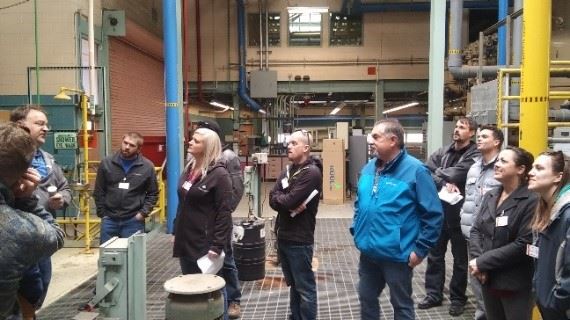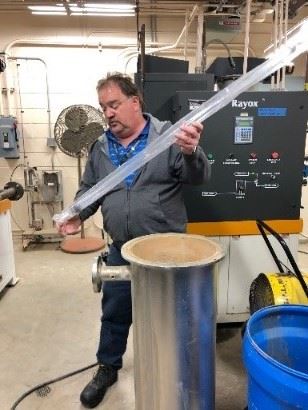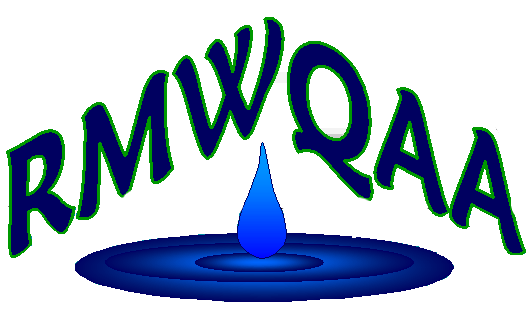On March 21st, members of the RMWEA/RMSAWWA Lab Practices
Committee(LPC) and RMWQAA toured the wastewater treatment plant at the Lockheed Martin Space Systems, Waterton Canyon located in Littleton, Colorado. This treatment plant serves the 6200-acre facility with a rich history of industrial use. The site was first constructed in the mid 1950’s to build the Titan I intercontinental ballistic missile. Since the initial build, the company had experienced several mergers and different focuses and has been known as Lockheed Martin since 1997.
Over the years, the plant has manufactured hundreds of rockets designed to carry missiles, and communications satellites into space. Crafts such as the Titan, Gemini, Viking, Voyager, and Cassini were all built at the Waterton Canyon facility. Waterton Canyon was chosen specifically because the natural geology of the area provided more security and noise control than other sites. In fact, the location tops a 1,700-foot-deep bedrock formation that isolates it from even the smallest seismic movement and provides the ultimate environment for testing the stability of various systems.
Early years of rocket launch testing contaminated the soil and groundwater with rocket fuel and manufacturing chemicals. The EPA declared it a Superfund site in 1989, however, this designation was soon removed. Initial clean-up efforts included removal of contaminated soil, wells, and solid waste. Decades later the main contaminant remaining in the groundwater is N-nitrosodimethylamine (NDMA), which is a breakdown product of hydrazine rocket fuel. Lockheed’s industrial wastewater treatment plant is responsible for treating the groundwater as well as production waste from space component manufacturing processes. Domestic waste is collected and piped to South Platte Water Renewal Partners (previously known as Littleton/Englewood Wastewater Treatment Plant) where it is treated and discharged into segment 6a of the South Platte River.
The NDMA contaminated groundwater treatment has been going on continually for the past 20 years. Luckily, the geography of the area funnels groundwater into two main channels making it easy to reclaim all of it for treatment. NDMA is treated via UV Photolysis where it’s degraded using high levels of UV irradiation. The Nitrogen bonds are broken leaving NO and (CH3-N=CH2). The NO then gets oxidized into nitrite and then nitrate. The dimethylamine oxidizes to form bicarbonate. The UV bulbs are similar to the bulbs used in domestic wastewater plants, but instead of having a group of bulbs in a grid, only one very high-powered bulb is used.
 Initial levels of NDMA in the groundwater were around 300 ppb. After 20 years of continual treatment, the levels have dropped to about half, and through treatment, they are able to meet their permit limit for NDMA.
Initial levels of NDMA in the groundwater were around 300 ppb. After 20 years of continual treatment, the levels have dropped to about half, and through treatment, they are able to meet their permit limit for NDMA.
Other waste streams contain high levels of chromium and zinc from manufacturing or washing processes. Aluminum is etched off of casings of crafts to minimize the weight and fuel it takes to launch. Chromium plating is used to prevent oxidation. The metals are treated using hydroxide precipitation, followed by polymer flocculation. The sludge is then dewatered with a sludge press and dried for disposal. The final effluent water goes through sand filtration, Nitrite oxidation, carbon feed, granular activated carbon (GAC), ion exchange, and final pH adjustment.
The industrial wastewater treatment plant discharges just upstream of Chatfield Reservoir, which requires discharges to meet stringent fishery, recreation, and drinking water standards outlined in Control Regulation Reg 73 that can be found here: https://www.colorado.gov/pacific/sites/default/files/73_2009%2803%29header.pdf
Lockheed Martin hasn’t had a permit violation for decades and has actively participated in the Chatfield Watershed Authority. The tour was very informative and interesting. Although we didn’t get to tour any of the rest of the top-secret, high-security site, we did see the hillside that they once launched rockets into as well as a peek at the new $350 million dollar Gateway Center right next door to the plant. You can read more about that here: https://www.lockheedmartin.com/en-us/capabilities/space/gateway-center.html
Michelle Neilson, Water Quality Technician, has been with Metro Wastewater for 8.5 years. She has a B.S. in Chemistry, and has 19 years of experience in the Environmental field. Michelle has worked for USGS, contract laboratories, and several municipal wastewater and drinking water labs prior to Metro Wastewater.
 Welcome to the
RMWQAA Website!
Welcome to the
RMWQAA Website!  Welcome to the
RMWQAA Website!
Welcome to the
RMWQAA Website!